Effects of Seasonal Variation on Spatial and Temporal Distributions of Ozone in Northeast China
Abstract
:1. Introduction
2. Materials and Methods
2.1. Study Area
2.2. Data Sources
2.3. Methods
2.3.1. Spatial Autocorrelation Analysis
2.3.2. Cold–Hot Spot Analysis
2.3.3. Geographical Detector
3. Results
3.1. Temporal Variation in O3 Concentrations
3.1.1. Annual Variation
3.1.2. Seasonal Variation
3.1.3. Monthly Variation
3.2. Spatial Variability in O3 Concentrations
3.2.1. Annual Variation
3.2.2. Seasonal Variation
3.3. Spatial Aggregation Characteristics of O3 Concentration
4. Discussion
4.1. Relationships among O3, Meteorological Factors, and Atmospheric Pollutants
4.2. Seasonal Effects of Meteorological Factors and Precursor on O3
4.3. Effects of Meteorological Factors, Green Land Area, and Precursor on Different O3 Pollution Levels
5. Conclusions
Author Contributions
Funding
Institutional Review Board Statement
Informed Consent Statement
Data Availability Statement
Acknowledgments
Conflicts of Interest
References
- Wu, B.; Liu, C.Q.; Zhang, J.; Du, J.; Shi, K. The multifractal evaluation of PM2.5-O3 coordinated control capability in China. Ecol. Indic. 2021, 129, 107877. [Google Scholar] [CrossRef]
- Shi, J.W.; Wang, Z.H.; Zhao, C.Y.; Han, X.Y.; Wang, J.M.; Yang, X.X.; Xie, H.T.; Zhao, P.W.; Ning, P. Characteristics and causes of ozone pollution in 16 cities of Yunnan Plateau. Atmosphere 2022, 13, 1177. [Google Scholar] [CrossRef]
- Ge, Y.Z.; Chen, C.Q.; Jiang, Y.P.; Yang, T.S.; Kang, H.Y.; Li, J.Z.; Zhao, X.R.; Zhang, Y.B.; Li, M.Y.; Hou, T.Y.; et al. Characteristics of ozone pollution in Tai’an and topographic effects of Mount Tai. Atmosphere 2022, 13, 1299. [Google Scholar] [CrossRef]
- Lu, X.; Zhang, L.; Wang, X.; Wang, X.L.; Gao, M.; Li, K.; Zhang, Y.Z.; Yue, X.; Zhang, Y.H. Rapid increases in warm-season surface ozone and resulting health impact in China since 2013. Environ. Sci. Technol. Lett. 2020, 7, 240–247. [Google Scholar] [CrossRef]
- Tang, H.Y.; Liu, G.; Zhu, J.G.; Han, Y.; Kobayashi, K. Seasonal variations in surface ozone as influenced by Asian summer monsoon and biomass burning in agricultural fields of the northern Yangtze River Delta. Atmos. Res. 2013, 122, 67–76. [Google Scholar] [CrossRef]
- Xu, D.N.; Yuan, Z.B.; Wang, M.; Zhao, K.H.; Liu, X.H.; Duan, Y.S.; Fu, Q.Y.; Wang, Q.; Jing, S.G.; Wang, H.L.; et al. Multi-factor reconciliation of discrepancies in ozone-precursor sensitivity retrieved from observation- and emission-based models. Environ. Int. 2022, 158, 106952. [Google Scholar] [CrossRef] [PubMed]
- Abdul-Wahab, S.A.; Bakheit, C.S.; Al-Alawi, S.M. Principal component and multiple regression analysis in modelling of ground-level ozone and factors affecting its concentrations. Environ. Modell. Softw. 2005, 20, 1263–1271. [Google Scholar] [CrossRef]
- Yu, R.L.; Lin, Y.L.; Zou, J.H.; Dan, Y.B.; Cheng, C. Review on atmospheric Ozone pollution in China: Formation, spatiotemporal distribution, precursors and affecting factors. Atmosphere 2021, 12, 1675. [Google Scholar] [CrossRef]
- Tilmes, S.; Kinnison, D.E.; Garcia, R.R.; Salawitch, R.; Canty, T.; Lee-Taylor, J.; Madronich, S.; Chance, K. Impact of very short-lived halogens on stratospheric ozone abundance and UV radiation in a geo-engineered atmosphere. Atmos. Chem. Phys. 2012, 12, 10945–10955. [Google Scholar] [CrossRef] [Green Version]
- Wang, X.S.; Li, J.L.; Zhang, Y.H.; Xie, S.D.; Tang, X.Y. Ozone source attribution during a severe photochemical smog episode in Beijing, China. Sci. China Ser. B 2009, 52, 1270–1280. [Google Scholar] [CrossRef]
- Wang, X.Y.; Zhao, W.H.; Zhang, T.Y.; Qiu, Y.; Ma, P.F.; Li, L.J.; Wang, L.L.; Wang, M.; Zheng, D.Y.; Zhao, W.J. Analysis of the characteristics of Ozone pollution in the North China Plain from 2016 to 2020. Atmosphere 2022, 13, 715. [Google Scholar] [CrossRef]
- Liu, P.F.; Song, H.Q.; Wang, T.H.; Wang, F.; Li, X.Y.; Miao, C.H.; Zhao, H.P. Effects of meteorological conditions and anthropogenic precursors on ground-level ozone concentrations in Chinese cities. Environ. Pollut. 2020, 262, 114366. [Google Scholar] [CrossRef]
- Huang, X.G.; Shao, T.J.; Zhao, J.B.; Cao, J.J.; Song, Y.Y. Spatial-temporal variation and driving factors of ozone concentration in the Yangtze River Delta urban agglomeration. Resour. Environ. Yangtze Basin 2019, 28, 1434–1445, (In Chinses with English Abstract). [Google Scholar]
- Ke, B.Q.; He, C.; Yang, L.; Ye, Z.X.; Yi, J.H.; Tian, Y.; Mu, H.; Tu, P.Y.; Han, C.R.; Hong, S. Spatial and temporal distribution of surface ozone and its driving factors in North China. China Environ. Sci. 2022, 42, 1562–1574, (In Chinese with English Abstract). [Google Scholar]
- Wang, W.J.; Parrish, D.D.; Wang, S.W.; Bao, F.X.; Ni, R.J.; Li, X.; Yang, S.D.; Wang, H.L.; Cheng, Y.F.; Su, H. Long-term trend of ozone pollution in China during 2014–2020: Distinct seasonal and spatial characteristics and ozone sensitivity. Atmos. Chem. Phys. 2022, 22, 8935–8949. [Google Scholar] [CrossRef]
- Chen, Z.Q.; Shao, T.J.; Zhao, J.B.; Cao, J.J.; Yue, D.P. Spatial pattern evolution and influencing factors of ozone concentration in Northeast China. Acta Sci. Circumstantiae 2020, 40, 3071–3080, (In Chinese with English Abstract). [Google Scholar]
- Gao, C.; Xiu, A.J.; Zhang, X.J.; Chen, W.W.; Liu, Y.; Zhao, H.M.; Zhang, S.C. Spatiotemporal characteristics of ozone pollution and policy implications in Northeast China. Atmos. Pollut. Res. 2019, 11, 357–369. [Google Scholar] [CrossRef]
- Moran, P.A.P. The interpretation of statistical maps. J. R. Stat. Soc. B 1948, 37, 243–251. [Google Scholar] [CrossRef]
- Geary, R.C. The contiguity ratio and statistical mapping. Inc. Stat. 1954, 5, 115–145. [Google Scholar] [CrossRef]
- Yang, L.F.; Xie, D.P.; Yuan, Z.B.; Huang, Z.J.; Wu, H.B.; Han, J.L.; Liu, L.J.; Jia, W.C. Quantification of regional ozone pollution characteristics and its temporal evolution: Insights from identification of the impacts of meteorological conditions and emissions. Atmosphere 2021, 12, 279. [Google Scholar] [CrossRef]
- Gorai, A.K.; Biswal, S.S.; Mitra, G. Effects of meteorology on ground-level ozone (GLO) concentrations and identifying the hot spots having significantly higher GLO concentration in a semi-urban area. Environ. Dev. Sustain. 2018, 20, 1461–1481. [Google Scholar] [CrossRef]
- Wei, P.R.; Shao, T.J.; Huang, X.G.; Zhang, Z.D. Study on the spatial-temporal variation characteristics and driving factors of ozone concentration in Northeast China from 2015 to 2018. J. Ecol. Rural. Environ. 2020, 36, 988–997, (In Chinses with English Abstract). [Google Scholar]
- Zohdirad, H.; Jiang, J.H.; Aksoyoglu, S.; Namin, M.M.; Ashrafi, K.; Prévôt, A.S.H. Investigating sources of surface ozone in central Europe during the hot summer in 2018: High temperatures, but not so high ozone. Atmos. Environ. 2022, 279, 119099. [Google Scholar] [CrossRef]
- Li, L.L.; Wang, L.; Liu, X.P.; Wang, K.; Xu, Y.; Li, S.L.; Jiang, J.Q. Temporal and spatial distribution characteristics of ozone in Harbin and the relationship between meteorological elements. China Environ. Sci. 2020, 40, 1991–1999. [Google Scholar]
- Baidrulhisham, S.E.; Noor, N.M.; Hassan, Z.; Sandu, A.V.; Vizureanu, P.; Ul-Saufifie, A.Z.; Zainol, M.R.R.M.A.; Kadir, A.A.; Deák, G. Effects of weather and anthropogenic precursors on ground-level Ozone concentrations in malaysian cities. Atmosphere 2022, 13, 1780. [Google Scholar] [CrossRef]
- Chen, L.; Xiao, H.; Zhu, L.Y.; Guo, X.; Wang, W.Y.; Ma, L.; Guo, W.; He, J.Y.; Wang, Y.; Li, M.M.; et al. Characteristics of Ozone pollution and the impacts of related meteorological factors in Shanxi Province, China. Atmosphere 2022, 13, 1729. [Google Scholar] [CrossRef]
- Li, K.; Jacob, D.J.; Liao, H.; Shen, L.; Zhang, Q.; Bates, K.H. Anthropogenic drivers of 2013–2017 trends in summer surface ozone in China. Proc. Natl. Acad. Sci. USA 2019, 116, 422–427. [Google Scholar] [CrossRef] [Green Version]
- Tian, J.Q.; Fang, C.S.; Qiu, J.X.; Wang, J. Analysis of Ozone pollution characteristics and influencing factors in Northeast economic cooperation region, China. Atmosphere 2021, 12, 843. [Google Scholar] [CrossRef]
- Kinose, Y.; Yamaguchi, M.; Matsumura, H.; Izuta, T. Impact assessment of Ozone absorbed through stomata on photosynthetic carbon dioxide uptake by Japanese deciduous forest trees: Implications for Ozone mitigation policies. Forests 2020, 11, 137. [Google Scholar] [CrossRef] [Green Version]
- Agathokleous, S.; Saitanis, C.J.; Savvides, C.; Sicard, P.; Agathokleous, E.; Marco, A.D. Spatiotemporal variations of ozone exposure and its risks to vegetation and human health in Cyprus: An analysis across a gradient of altitudes. J. For. Res. 2022. [Google Scholar] [CrossRef]
- Huang, J.; Pan, X.C.; Guo, X.B.; Li, G.X. Health impact of China’s air pollution prevention and control action plan: An analysis of national air quality monitoring and mortality data. Lancet Planet Health 2018, 2, 313–323. [Google Scholar] [CrossRef] [Green Version]
- Belis, C.A.; Dingenen, R.V.; Klimont, Z.; Dentener, F. Scenario analysis of PM2.5 and ozone impacts on health, crops and climate with TM5-FASST: A case study in the Western Balkans. J. Environ. Manag. 2022, 319, 115738. [Google Scholar] [CrossRef]
- Wang, Z.H. Satellite-Observed effects from Ozone pollution and climate change on growing-season vegetation activity over China during 1982–2020. Atmosphere 2021, 12, 1390. [Google Scholar] [CrossRef]


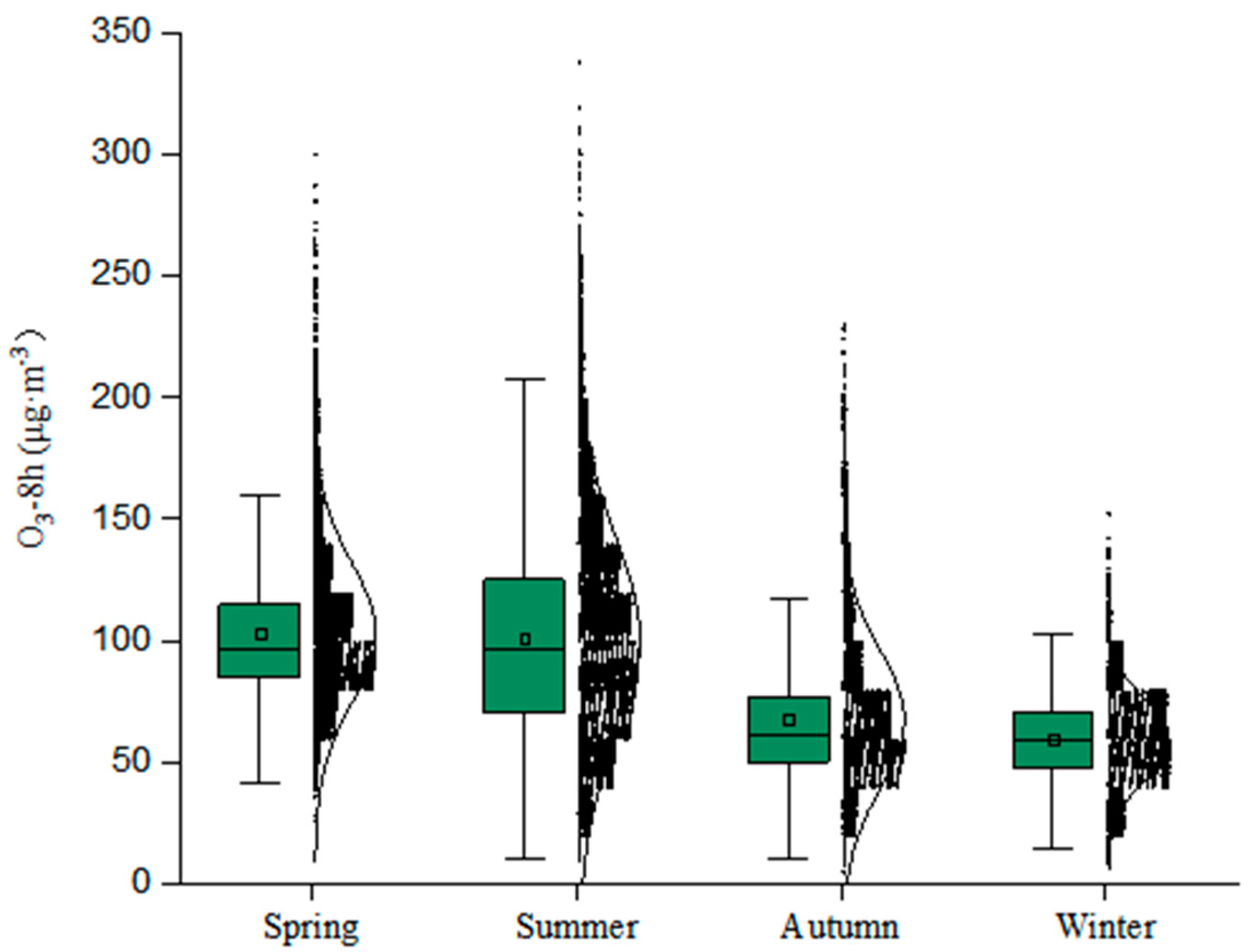


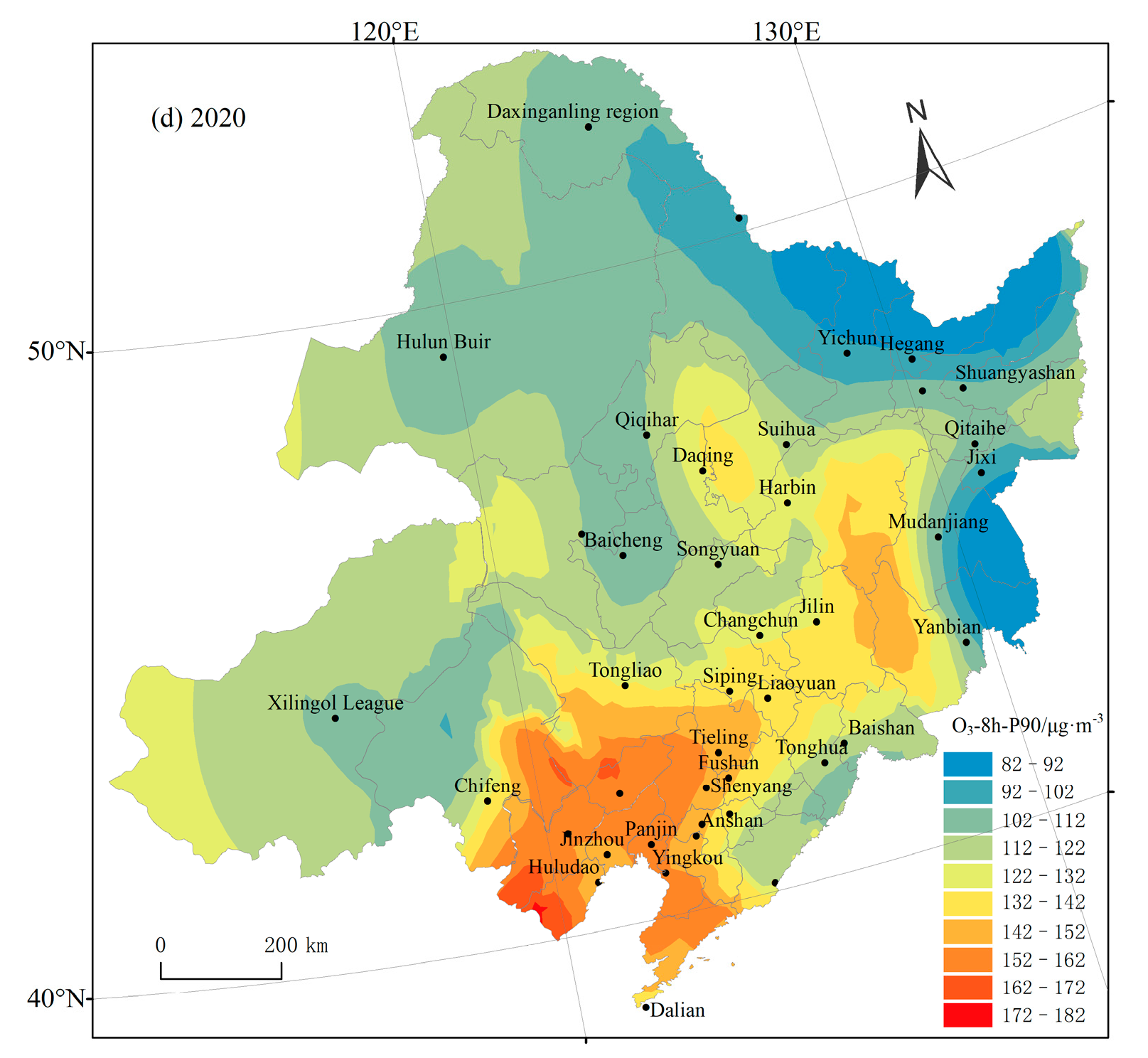
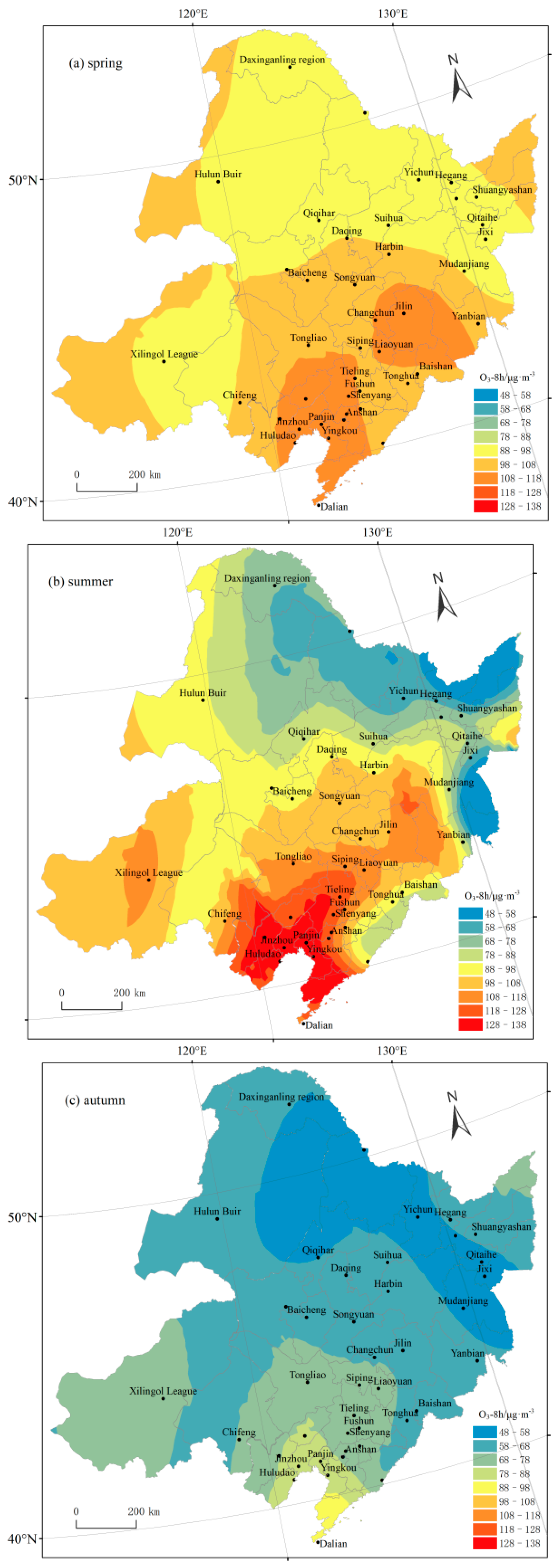
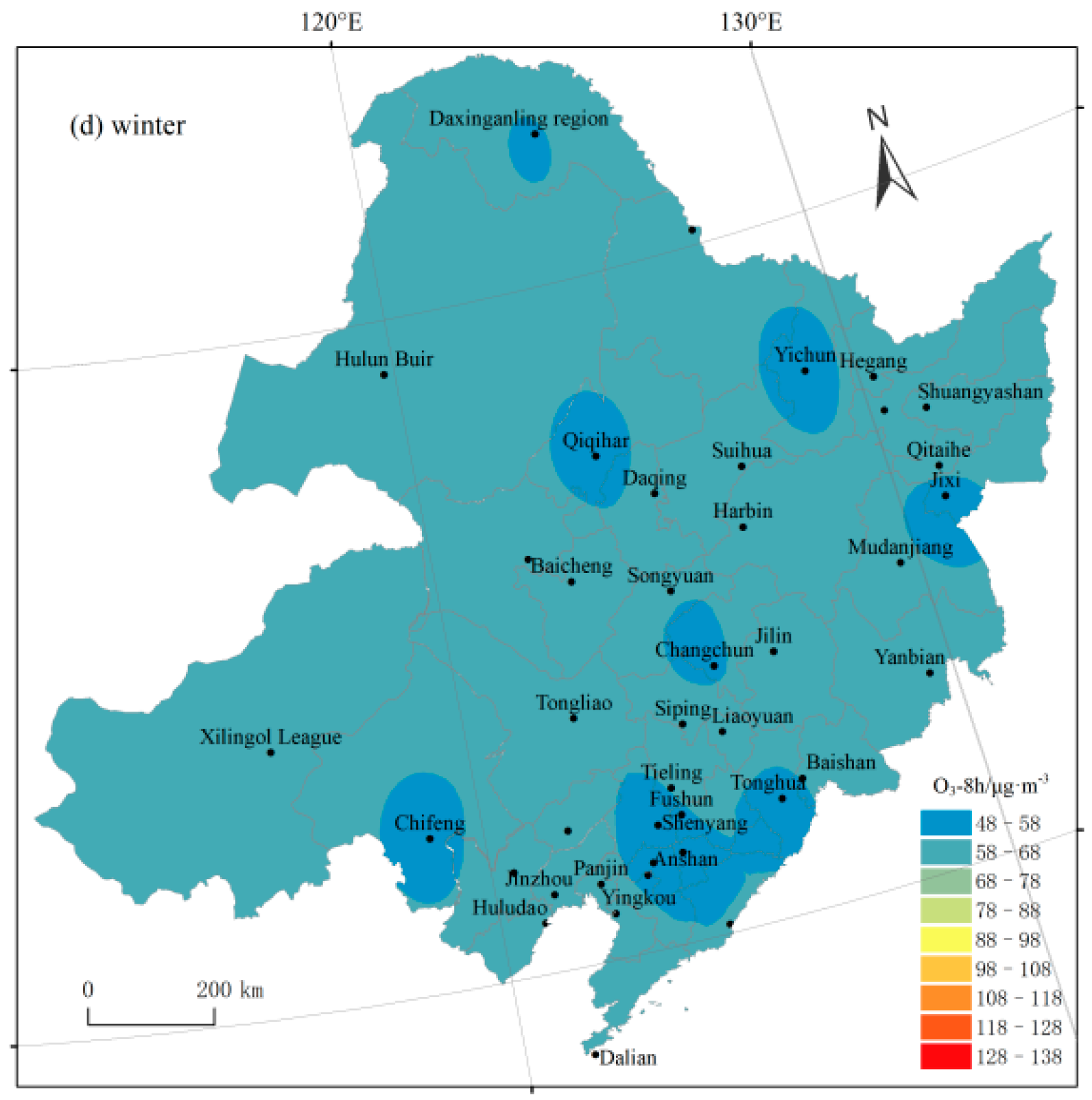

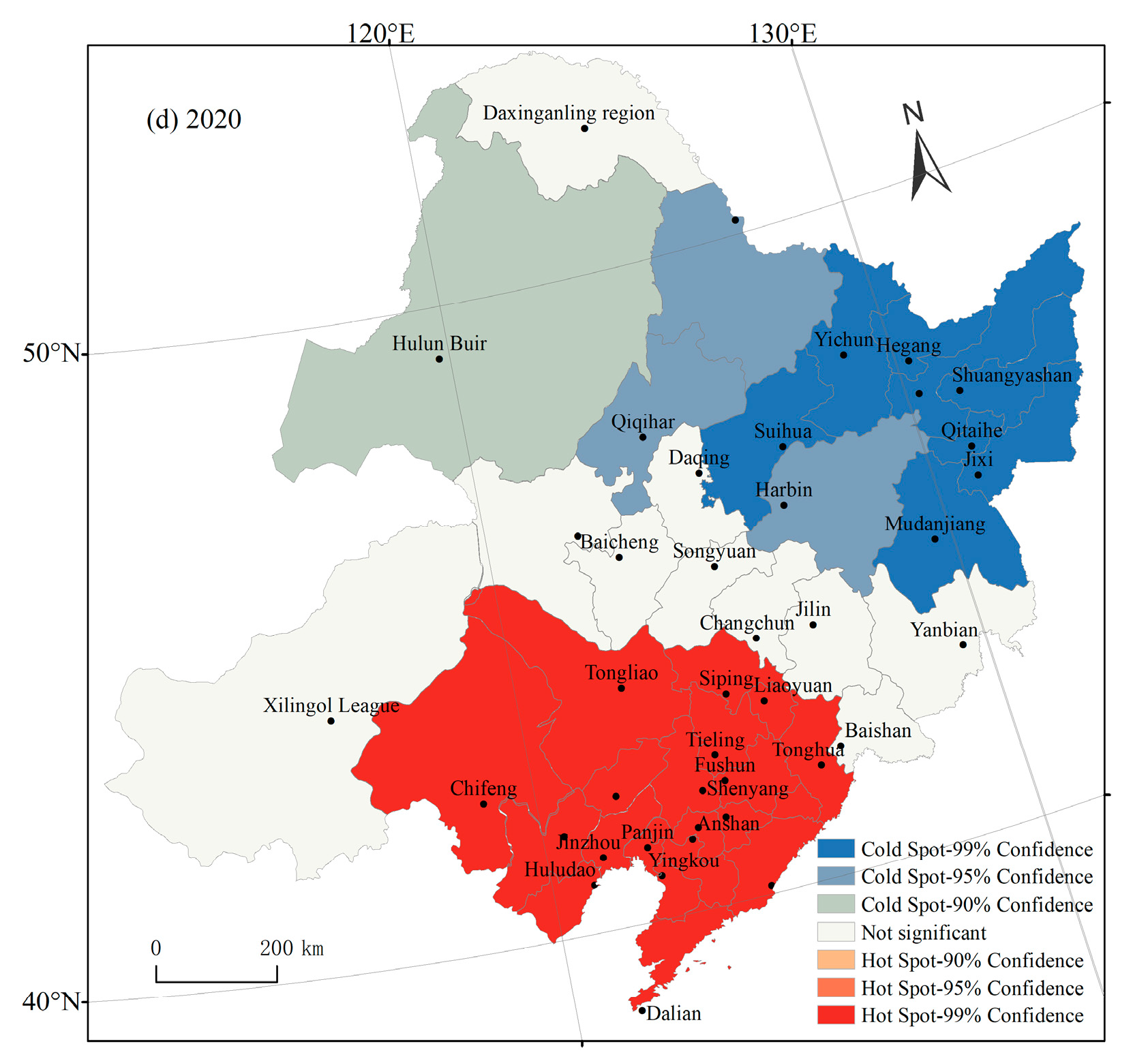
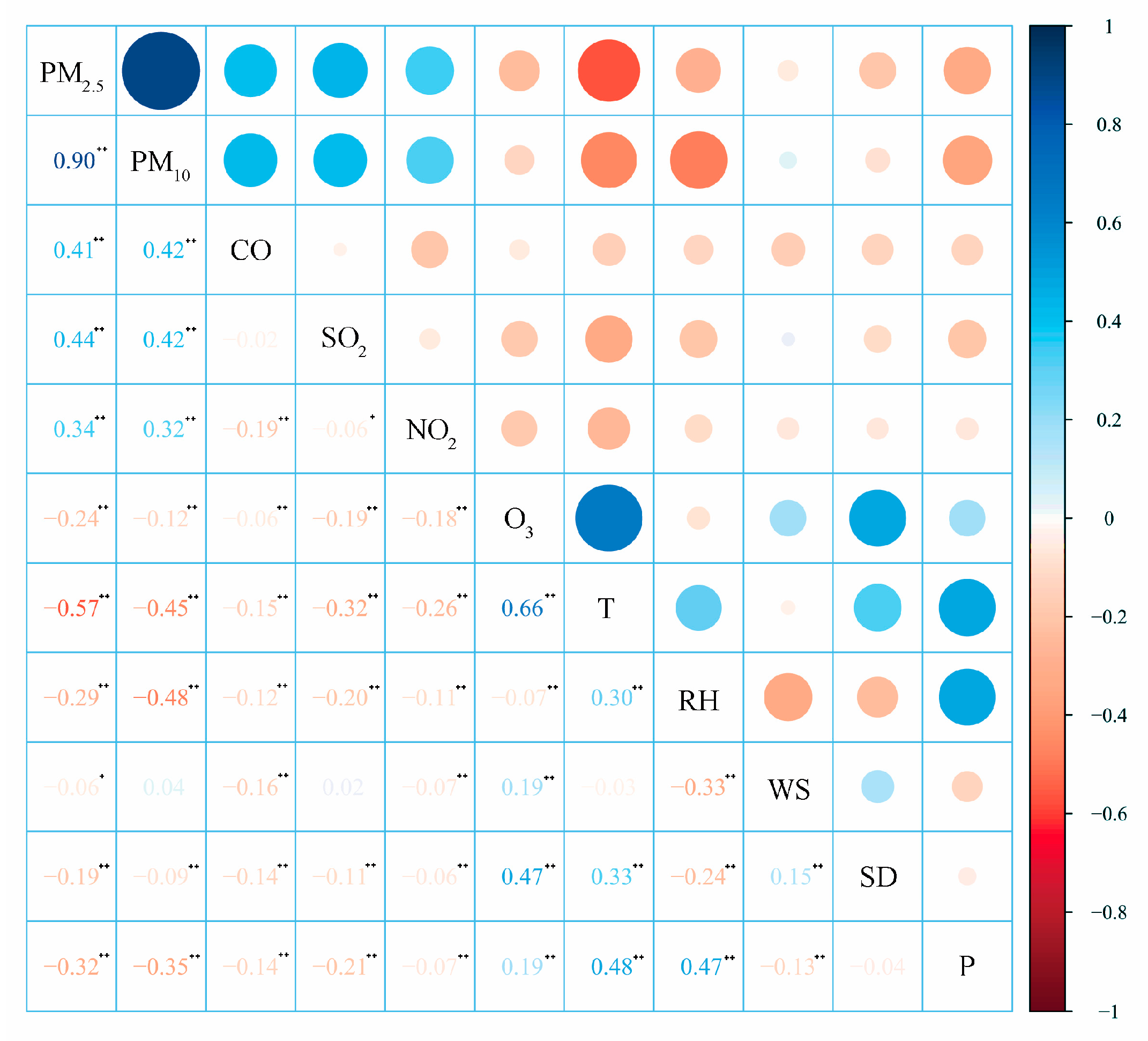
| Temperature | Relative Humidity | Wind Speed | Sunshine Duration | Precipitation | NO2 Concentrations | |
|---|---|---|---|---|---|---|
| Spring | 0.345 ** | −0.090 | 0.058 | 0.004 | −0.077 | −0.104 * |
| Summer | 0.205 * | −0.252 * | 0.027 | 0.091 | −0.136 * | 0.042 |
| Autumn | 0.294 * | 0.073 | 0.036 | 0.017 | −0.042 | −0.153 * |
| Winter | 0.067 | −0.082 | 0.043 | 0.011 | −0.015 | −0.217 ** |
| Temperature | Relative Humidity | Wind Speed | Sunshine Duration | Precipitation | Green Land Area | NO2 Concentrations | |
|---|---|---|---|---|---|---|---|
| Cold spots | 0.063 | −0.176 * | 0.104 | 0.002 | −0.043 | 0.137 * | −0.041 |
| Feature-free spots | 0.258 * | −0.126 * | 0.006 | 0.038 | 0.045 | 0.282 * | −0.108 * |
| Hot spots | 0.362 ** | 0.021 | 0.02 | 0.032 | −0.028 | 0.06 | −0.068 |
Publisher’s Note: MDPI stays neutral with regard to jurisdictional claims in published maps and institutional affiliations. |
© 2022 by the authors. Licensee MDPI, Basel, Switzerland. This article is an open access article distributed under the terms and conditions of the Creative Commons Attribution (CC BY) license (https://creativecommons.org/licenses/by/4.0/).
Share and Cite
Chen, J.; Sun, L.; Jia, H.; Li, C.; Ai, X.; Zang, S. Effects of Seasonal Variation on Spatial and Temporal Distributions of Ozone in Northeast China. Int. J. Environ. Res. Public Health 2022, 19, 15862. https://doi.org/10.3390/ijerph192315862
Chen J, Sun L, Jia H, Li C, Ai X, Zang S. Effects of Seasonal Variation on Spatial and Temporal Distributions of Ozone in Northeast China. International Journal of Environmental Research and Public Health. 2022; 19(23):15862. https://doi.org/10.3390/ijerph192315862
Chicago/Turabian StyleChen, Jin, Li Sun, Hongjie Jia, Chunlei Li, Xin Ai, and Shuying Zang. 2022. "Effects of Seasonal Variation on Spatial and Temporal Distributions of Ozone in Northeast China" International Journal of Environmental Research and Public Health 19, no. 23: 15862. https://doi.org/10.3390/ijerph192315862





